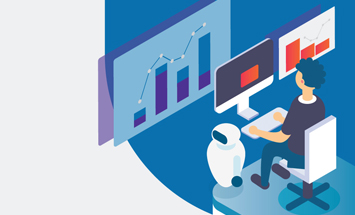AI Predictions for 2023
One of our AI specialist's, Tijana Nikolic, have pinpointed four predictions for AI in business in 2023. Read more about what she has to say about it in this blog.
2022 was the year that AI delivered on its promises, with generative models from OpenAI, Stability.AI and Midjourney making advanced AI accessible to a universal audience for the first time.
Most visible, perhaps, was Open AI’s OpenChat GPT, racking up 1 million users in just 5 days.
Equally significant were developments behind the scenes. In 2022, new Machine Learning Operations (MLOps) services put the focus on scalability and support for important elements of the AI pipeline, including data engineering, model validation and trusted AI development.
Having made a big bang in the creative community, technologists must now turn their minds to answering the difficult ethical questions raised by AI, and to making services efficient, responsible, sustainable and scalable. Here are our four predictions for AI in business in 2023.
Prediction #1: Generative AI will grow up
Generative models are AI services that can learn to create data, including text, images and music. OpenAI’s DALL-e, GPT-3 and ChatGPT, Stability.ai’s Stable Diffusion and Midjourney all require users to input a word or phrase, which is then used to generate new, unique content.
To date, these outputs have most often been images or text, but in 2023, we’ll see a shift toward generating audio and film content. The quality of outputs will improve and services will be optimized for efficiency and scalability – including by using smaller datasets.
How we use generative AI will also change. One important point of debate in 2022 was Stability.ai’s decision to publish their AI models under a creative license, to prevent the technology from being used for morally objectionable purposes. In 2023, we will see these types of licenses evolve and expand, together with new frameworks for ensuring responsible use.
Prediction #2: AI will become more practical
In 2022, MLOps changed the game by putting the spotlight on the scalability, reliability and efficiency of AI.
2023 will build on this progress. We’ll see advances in the optimization of AI workloads, servers and storage. Data distribution will be made simpler, making training, inferencing and other activities more efficient. Testing will become easier, and be streamlined to support mainstream applications.
As a result, 2023 will be the year that AI finally stops being ‘magical’ and standalone, and instead earns a place within smart systems for business decision-making. This will drive the mainstream use of AI in real-world applications, with a focus on delivering tangible benefits and results in industries such as healthcare, finance, transport and manufacturing.
As AI enters the mainstream, technologists will be under pressure to further demystify and democratize AI to increase user numbers. This leads us to…
Prediction #3: Trusted AI will drive increased adoption
Trusted AI systems are designed to be reliable, transparent and accountable in their decision-making and behavior, to protect the privacy, security and rights of individuals and their data.
As AI becomes more sophisticated and widely used, it will become increasingly important to ensure that AI is used in a responsible and ethical manner. This is especially true in fields like healthcare, finance and law, where AI systems are increasingly being used to make decisions that significantly impact people’s lives.
In 2023, we will therefore see a consolidated push towards trusted AI systems, where companies, society and organizations demand increased transparency and clear explanations of the output of AI models. This will be enforced by new regulations, like those being considered by the EU.
Prediction #4: SustAInability will come to the fore
AI has and will continue to play a significant role in promoting sustainability, by enabling organizations to manage resources, manage waste and pollution more efficiently, and to develop solutions for environmental challenges like biodiversity loss.
On the other side of the coin, 2023 will also see the development of more energy-efficient AI algorithms and hardware, and the publication of new frameworks on sustainable AI design – both crucial for reducing the carbon footprint generated by AI.
AI predict AI
In the spirit of 2022’s AI advancements, I wanted to give the last word to AI itself.
What trends does OpenAI’s ChatGPT predict for AI in 2023?
“It is difficult to make predictions about the future, especially when it comes to specific technologies like AI. However, some general trends that are likely to continue in the field of AI include the development of more advanced and intelligent machine learning algorithms, the growth of the Internet of Things (IoT) and the increasing use of AI in a wide variety of industries and applications. Additionally, there is likely to be a continued focus on ethics and the responsible use of AI, as well as on issues related to the potential impact of AI on the workforce and society as a whole.”
Not bad, right?
Maybe next year’s blog will be completely written by a model like this one!
To find out more, get in touch today!
- Tijana NikolicAI Specialist, Netherlands
+31 34 724 20 46
 Tijana NikolicAI Specialist, Netherlands
Tijana NikolicAI Specialist, Netherlands
+31 34 724 20 46
- Joakim WahlqvistGlobal Data & AI Lead
+46 70 345 18 01
 Joakim WahlqvistGlobal Data & AI Lead
Joakim WahlqvistGlobal Data & AI Lead
+46 70 345 18 01




